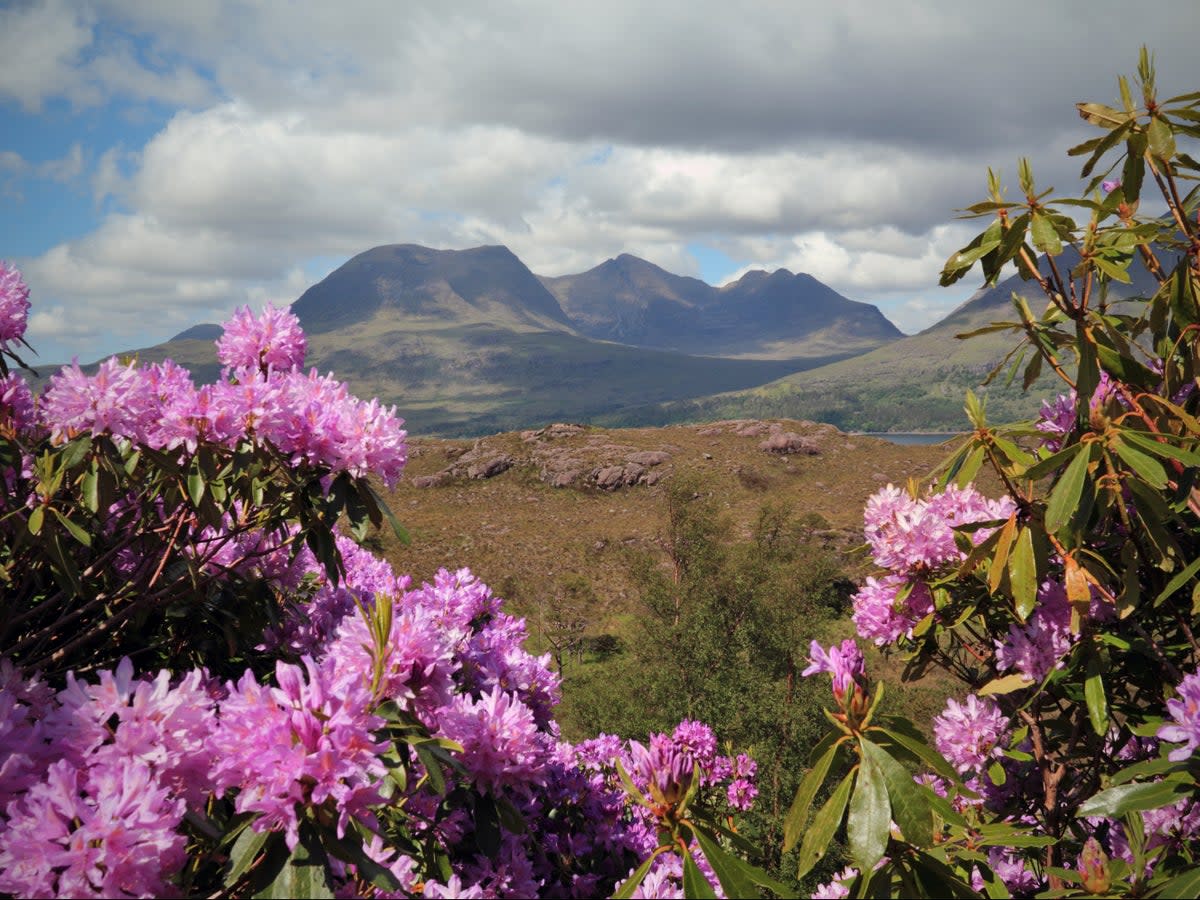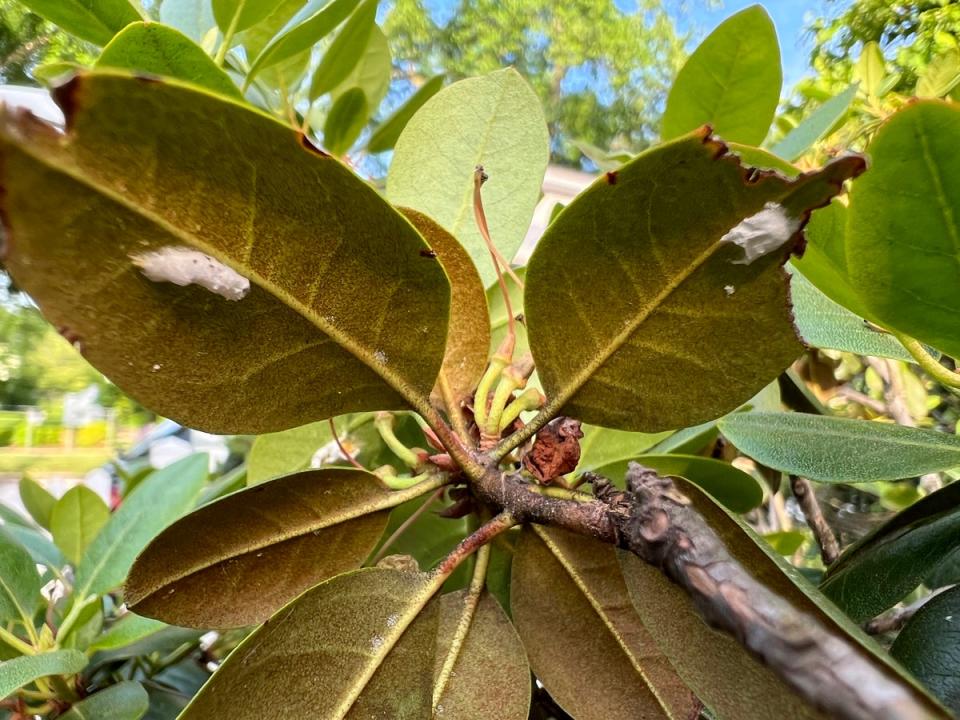Deadly beautiful: How rhododendrons are threatening the UK’s most vulnerable woodlands

It is spring in Gwynedd, north Wales, and looking up into the rich canopy of foliage gripping the craggy coastline, delicate oak tree leaves are stretching their fresh, knobbly lobes in the sunshine.
Lower down, brilliant pink and purple flowers explode like fireworks in the shadows. They erupt from thickets of broad leathery leaves and curling branches that weave and arch over bare earth.
But as beguiling as these floral pyrotechnics might be, they are a sign of a worsening environmental disaster. The bare earth beneath these plants is practically barren. These are Rhododendron ponticum – where they thrive, little else can.
Across the country our woodland ecosystems are suffering. The trees are thinning, the insects and birds are dying, with humanity’s wars against nature being waged on several fronts, ultimately taking huge tolls on forest habitats.
Despite new-found concern for trees thanks to the need to draw down carbon from the atmosphere and boost biodiversity, just 7 per cent of Britain’s native woodlands are currently in good ecological condition, mainly because of a simultaneous storm of factors, including imported diseases, invasive plants, mammal browsing, the climate crisis and air pollutants.
Rhododendrons’ impacts are acute. This fast-growing shrub, which was a Victorian and Edwardian garden favourite, chokes out all native competitors. Tree seedlings have no chance of stretching up to the light in the shade of a rapidly expanding rhododendron and can’t compete with these plants’ rate of reproduction.
“They’re a huge menace. They’re triffids. They are one of the biggest threats to our temperate rainforests and there needs to be a nationwide programme to eradicate them,” environmental campaigner and author Guy Shrubsole tells The Independent.
Though globally rare temperate rainforests once covered up to a fifth of the country, pockets of these astonishing ecosystems now persist in the UK only by sheer luck.
Around the world temperate rainforest is thought to be more threatened than tropical rainforest habitats. In the UK these last few stands of trees are found in parts of the west coast of Scotland and Wales and in tiny areas of England and Northern Ireland.
They have miraculously survived clearances, chronic overgrazing – mainly by sheep and deer – and conversion to other land uses, but are now just fragments of what was once a richly biodiverse ecosystem supporting countless species of plants, insects, funghi, lichens, birds and mammals. Now less than 1 per cent of Britain has temperate rainforest growing on it.

One of the biggest threats to the recovery of this lost world is rhododendrons.
Described as “the most damaging and most widespread non-native terrestrial plant in Britain” by the Woodland Trust, it is both very difficult and very expensive to remove once it arrives, with estimates that more than £400m will need to be spent to clear Scotland. In 2018, just £2m was allocated to their removal.
These plants first came to the UK relatively recently. Rhododendron ponticum is native to some areas around the Black Sea, the Balkans and the Iberian Peninsula. It was first brought to Britain in the 1760s, according to the Woodland Trust, but its popularity boomed in the mid-19th century as landed gentry sought to bring swathes of colour to ornamental gardens.
“I’ve come to see behind the beauty of the purple flowers and appreciate the menace that lurks behind them,” says Shrubsole.
“I think it’s another way in which the Victorians screwed us up really. Victorian aristocrats and gentry popularised the mania for rhododendrons – both for decorative gardens but also as game cover for pheasant shoots. Because they’re evergreen, they provide cover all year round.
“It is understandable that when the public visit all these lovely landscaped gardens, which are from the era of big stately gardens laid out with loads of rhododendrons, we obviously see that as beautiful – and there is a beauty to them. But we need to recognise how much of our ecosystems we’ve lost, and rhododendrons need to become part of Britain’s reckoning with its history of ecological decline.”
Despite us now understanding the threat this plant poses to woodlands, it remains popular.
Though it is listed as an invasive species, plants can still be bought from garden centres, it can be legally grown and the Royal Horticultural Society website offers growing tips – alongside the recommendation not to plant it.
As a result, come springtime the purple five-pointed stars of rhododendrons can be found across the country, from windswept cliffs and heathlands to parklands, private gardens and, of course, in the ornamental gardens of stately homes.
Knowledge of the plant’s threat to woodlands is not well recognised. A search for rhododendrons on social media returns hundreds of results showing photographs of pink and purple blooming bushes, with posts celebrating these plants’ attractiveness.
The word rhododendron comes from the ancient greek rhódon – meaning rose – and déndron – meaning tree. But this not-quite-rose, not-quite-tree neither supports pollinating insects and nesting birds in the way a rose does, nor offers the enormous benefits of a native tree species.
Rhododendrons are poisonous to most honeybees, but the one definite upside they have is that they are an excellent source of food for bumblebees.
“They do provide floral resources in areas where perhaps there might not be very much,” says Professor Phil Stevenson from the Royal Botanic Gardens at Kew.
In the plant’s native ranges in Turkey, the honeybees have adapted, however, and produce a product known, delightfully, as “mad honey”.

“Do you know about ‘mad honey’?” Professor Stevenson asks. I don’t.
“Mad honey is a psychotropic product made from honey, which people consume for its psychoactive effects,” he says.
The chemicals in the rhododendron nectar are toxic to numerous species, including humans, so when used by bees to produce honey that is then eaten by people, a variety of effects can occur, from light-headedness and hallucinations when taken in small doses, to nausea, loss of coordination and muscular weakness.
One of the earliest reports of its use was apparently in 67BC, when Gnaeus Pompeius Magnus (Pompey the Great) and his Roman army were pursuing King Mithridates of Pontus and his Persian army along the Black Sea during the Mithridatic Wars. During the chase, the Persian army deployed pots of honey made with rhododendron nectar along the road for the Romans to find.
Discovering the bounty, the Romans ate the honey, only to become disorientated to the point of extreme vulnerability, at which point King Mithridates’ army returned and, it is said, slaughtered 1,000 Roman soldiers.
“That is probably the first example of a chemical weapon of war,” says Professor Stevenson.
“But they [rhododendrons] are damaging to the point of excluding all other plant species.”
He also suggests that rhododendrons could affect soils, making them increasingly attuned to producing yet more rhododendrons, which would further exacerbate their impact.
Speaking about the plant’s enduring popularity, he suggests that other invasive plants, such as Japanese knotweed and Indian balsam, have been more likely to be the subject of negative media reports.
“Rhododendron ponticum might be a better target if it had a nation behind it,” he half jokes.
“In Britain we think everything that’s foreign is horrible, so Japanese knotweed really captures the imagination – ‘it’s the Japanese invading with their weeds’ – but maybe with rhododendron it’s regarded more as a pretty flower.”
Given the ecological damage rhododendrons are wreaking in the British Isles, it is perhaps surprising that it is still available for sale from mainstream garden centres.
There are growing calls for this to change.
George Anderson of the Woodland Trust tells The Independent that invasive rhododendron continues to be offered for sale by plant nurseries in the UK, both as a flowering plant and as the rootstock for grafted rhododendron species.
“A Defra consultation in 2009 included Rhododendron ponticum on a list of 15 alien species that were being considered for a sales ban. The Horticultural Trades Association expressed concern that a ban would be difficult to implement, and growers and retailers would be disproportionately affected.
“The continued sale and planting of invasive rhododendrons in the UK, especially in the rainforest, clearly increases the risk of further spread to new locations.”
He says the Woodland Trust would like to see Rhododendron ponticum “banned from the UK garden market both as a plant in its own right and as rootstock onto which other species are grafted”.
“No bloom is worth the loss of our native woodlands and the rich wildlife they support.”
On the north Welsh coast, beneath the swaying oak trees, the rhododendrons squat in the gloom, biding their time.
When these trees fall it would not only be sad from a human perspective if there were no young broad-leaved trees growing to fill the gaps in the canopy, but it would also be a huge loss to the species that depend on them.
In a country recognised as being ‘one of the most nature depleted’ in the world, can we afford to lose any more?

 Yahoo News
Yahoo News 
